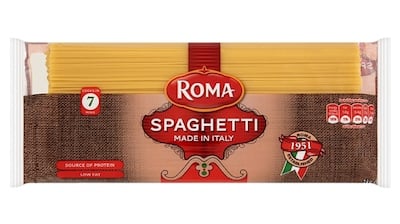When I was a student, carbohydrates were not a contentious topic. That’s partly because many of us were not sure what they were. Those of us not taking home economics as a subject didn’t come across the word often.

The exceptions were newspaper articles exhorting us to follow the example of top athletes and “carb load” with pasta for energy.
What I gleaned was that pasta was good because it had lots of carbohydrates, which gave you energy. Sadly, eating like a sporting hero will not make you into one if you don’t do similar levels of exercise. These days, high-protein diets are favoured and pasta is blamed for being having too many calories and carbohydrates.
So should we pass on the pasta?
The answer to that may lie on the labels.
Pasta is usually made from wheat, though it can also be made from corn, buckwheat, chickpeas or other ingredients.
There is often only one ingredient. Roma spaghetti, for example, is made from durum wheat semolina, a coarse flour. It is popular because, thanks to the gluten, it holds together well. (Semolina can also be bought as a powder and used to make pudding, for a taste of 1970s Ireland.) The products are produced and packed in Italy for Irish group Valeo Foods in Dublin, which is why there is an Italian flag on the front of the packet.

Check out the nutrition label on the Roma wheat spaghetti and you will see that each 100g serving has 72g of carbohydrate. That’s a lot more than you would find in the same amount of potato. It’s also far beyond the 50g-100g allowed on many low-carb, weight-loss diets.
There’s more to it than that, however. This pasta also has 1g of fat, 3g of fibre and 12g of protein. So it is naturally low in fat and can be considered a source of protein, which can help one feel satisfied for longer. A 100g serving comes in at 353 calories, before any sauce is added.
Wholewheat
Compare that information with the nutrition label on Roma’s wholewheat spaghetti to see why many dieticians recommend eating that version of the popular staple instead. Wholewheat pasta uses all of the wheat kernel, so it is more nutritious and has more fibre.
The notes mention that this wholewheat pasta is “high in fibre and a source of protein”. The figures back that up showing that a serving has 8.4g of fibre and 14.1g of protein. So the wholewheat spaghetti has almost three times as much fibre as the paler version. Given that nutritionists repeatedly tell us that we are not getting enough fibre in this country, this might be one way to make a simple change for the better in your diet.
We should be eating 25-35g of fibre a day, but most people get about half that amount. (The recommended level for children is their age plus 5g fibre per day. So a 10-year-old should be getting 15g every day.)
The wholewheat pasta also has fewer calories than regular pasta at 337 a serving, for those who can stick to the recommended portion size.
Those who cannot eat gluten can have buckwheat pasta from Orgran, which has similar levels of fibre and protein. Despite the name, buckwheat is not part of the wheat family so can be eaten by coeliacs too.
Edamame pasta such as that from Liberto, which is made from organic green soy beans, has even more to offer. Each 100g portion has 18g of fibre and 44g of protein. (It does, however, come all the way from China.)
Gluten-free
But don’t assume gluten-free is always better. Read the labels. Different types of pasta have different composition. Tesco’s free from corn pasta, for example, has just 1.7g of fibre and 3.1g of protein. That’s because it is made from rice flour, white maize flour, yellow maize flour, mono- and di-glycerides of fatty acids.
Pasta has been moved from its position at the base of the Department of Health’s food pyramid, along with other carbohydrates such as cereals, bread, potatoes and rice. This means that the number of servings it is advisable to eat per day has been reduced. It is now three to five, down from five to seven per day. Celebrity influencers online can be seen boasting they they haven’t had a carb in years, but Irish dieticians advise against cutting whole food groups.
Pasta is such a quick dish to make and can be nutritious when served in a reasonable portion size and with plenty of vegetables and some protein. So it would be a mistake to omit it completely.
FOOD LABELS SERIES
- Bread
- Soup
- Crisps
- Sliced ham
- Cream crackers
(search other food labels articles here)












